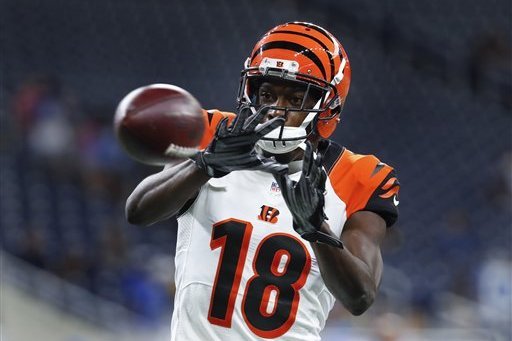
![]() The biggest debate about the first pick in a fantasy football draft seems to always come down to running backs against wide receivers.
The biggest debate about the first pick in a fantasy football draft seems to always come down to running backs against wide receivers.
But the answer might surprise some fantasy owners—either works. That’s the beauty of fantasy football, where an owner can get risky in the first round and still win a league. An Aaron Rodgers–Rob Gronkowski combo over the first two rounds has a way of doing that.
Owners can also go the more traditional route, of course, sticking to what has worked in the past and then using week-to-week savvy on the trade and waiver markets to fill needs as necessary.
It’s all viable, with the mock below based on standard scoring in a 12-team format providing one avenue for owners to explore. After, we take a look at some of the strategy going into the mock.
![]()
Selection Strategy Analysis
QBs
![]()
One of the first things owners will notice is the lack of a quarterback in the first round of the above draft.
The late-round quarterback strategy promises two things. One, owners can find a starting-caliber player each week on the waiver wire, which they can. Two, the position is ridiculously easy to predict because quarterbacks touch the ball more than anyone else.
Think back to last year. Streaming options such as Tyrod Taylor and Kirk Cousins came out of nowhere to act as close to a QB1 as owners can get, both scoring 258 or more points and finishing among the top 16 scorers at the position.
That’s 16 quarterbacks who scored at an elite level. While owners didn’t get burned taking Cam Newton (378 points) early, they sure did with Ben Roethlisberger (222), Andrew Luck (126) or Tony Romo (39).
Granted, this happens at every position, big-name guys going on to have miserable outings. But quarterback is different because there are so many surefire ways to avoid the pitfall or make up for it should it happen.
There’s nothing wrong with taking a quarterback early, but it’s like playing with a handicap at the other spots.
RBs
![]()
Running backs aren’t the kings anymore, but they’re steady production owners can take to the bank.
Los Angeles Rams back Todd Gurley is the new definition of this. He finished fifth in scoring last year at his spot despite missing three games, taking 229 carries for 1,106 yards and 10 scores.
Indeed, opportunity continues to equal production at the spot, hence Minnesota Vikings running back Adrian Peterson finishing second thanks to 327 carries, 1,485 yards and 11 touchdowns.
There simply aren’t backs to pass on in the first round, which is what makes Dallas Cowboys rookie running back Ezekiel Elliott so interesting. He’s a rookie, but so was Gurley, and his coaching staff figures to grind every game out with him, especially now that it’s hard to predict the availability of Romo thanks to injury.
Elliott has already showed encouraging signs in the preseason—and against the Seattle Seahawks defense, no less, via NFL Network:
![]()
In fact, the allure of passing to a guy by the name of Julio Jones is the only reason last year’s top-scoring back falls behind the three mentioned names.
Said top scorer was Devonta Freeman of the Atlanta Falcons, a guy who got it done in all facets on the way to 230 points, rushing for 1,061 yards and 11 scores with another 578 and three through the air.
Were it not for suspension (Le’Veon Bell) or injury (Jamaal Charles), other top names could mix up the first round a little more than this. But 2016, odd as it has been, seems to fall in place for the fantasy owners who love a little bit of everything.
WRs
![]()
Star wideouts continue to become more and more like their counterparts in the backfield, with a healthy dosage of targets going a long way toward notable production.
The problem, at least when comparing target-volume guys to running backs, is variables. Another wideout could steal the target. The line could block poorly. A defensive back could pick the ball off. The wideout could drop the pass. The quarterback could fall on his butt while dropping back. The…
…owners get the idea. It’s why Antonio Brown of the Pittsburgh Steelers comes off the board first. He had 195 targets last year and rode them to his landing as the top-scoring wideout. New York Giants star Odell Beckham Jr. was far behind with 159 targets, which he more impressively turned into the fifth slot.
We’ve already mentioned Jones, with Atlanta’s wideout coming off the board third because he led the league with 204 targets last year but only scored eight times.
It’s not hard to see the pattern the rest of the round. DeAndre Hopkins (192), A.J. Green (132) and Dez Bryant (72) all recorded significant targets, or would have if they hadn’t battled injuries.
As a whole, target hogs continue to do more and more damage by the year. Just look at the graph provided by Rotoworld’s Rich Hribar:
![]()
It’s no shock, then, that wide receivers make up half of the players selected in the first round of the above mock.
Albeit slowly, wideouts continue to elbow for more mental real estate in the minds of fantasy drafters. It’s important for owners to keep up with the pace to stay in contention of any leagues.
All scoring info and statistics courtesy of ESPN.com standard leagues, as are points-against info and ownership stats. Average draft position (ADP) courtesy of Fantasy Football Calculator.
Read more Fantasy Football news on NerdyFootball.com


